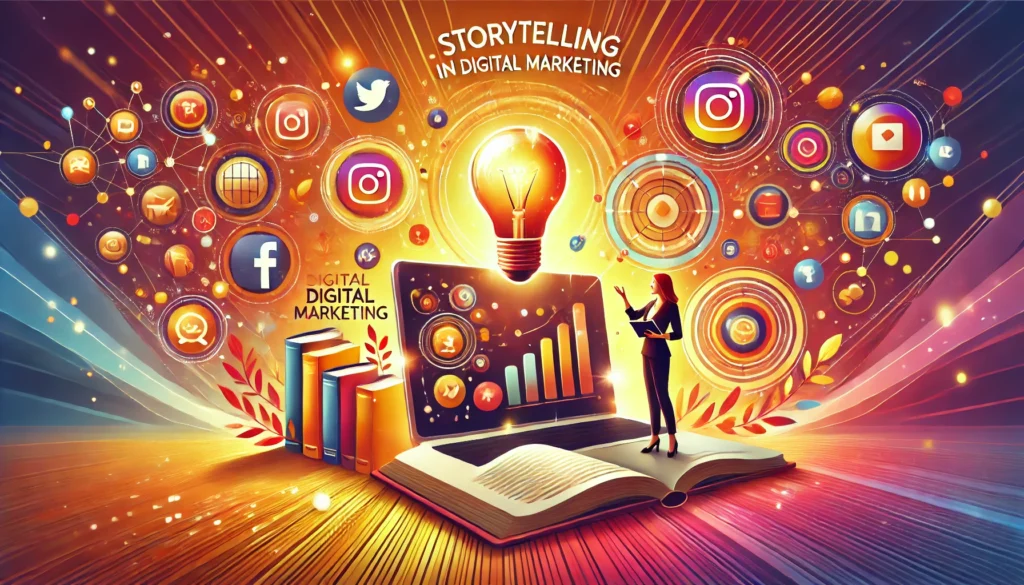In the ever-evolving world of digital marketing, standing out in a sea of content can be challenging. Attention spans are shrinking, and competition is fiercer than ever. Yet, there’s one timeless strategy that continues to captivate audiences and foster genuine connections—storytelling in digital marketing.
Stories have been an essential part of human communication for centuries. They entertain, inspire, and evoke emotions. When brands incorporate storytelling into their digital marketing strategies, they transform from faceless entities into relatable, memorable voices that resonate with their audience.
In this blog, we’ll explore the art of storytelling in digital marketing, its importance, how it works, and how you can master it to make your brand unforgettable.

Table of Contents
What is Storytelling in Digital Marketing?
Storytelling in digital marketing is the art of crafting and sharing stories that align with a brand’s message to engage and connect with its audience. These stories can take various forms, from customer testimonials and brand journeys to relatable scenarios that mirror the audience’s challenges and aspirations.
It’s not just about selling a product or service—it’s about selling an experience, a feeling, or a belief. Done well, storytelling transforms marketing from a transactional process into an emotional journey.
Why is Storytelling in Digital Marketing Important?
- Humanizes Your Brand:
People connect with people, not products. By sharing stories, your brand becomes more relatable and approachable. - Boosts Engagement:
Stories are inherently captivating. A well-told story can grab attention, keep audiences engaged, and encourage them to interact with your brand. - Builds Trust:
Stories show authenticity and transparency. Sharing challenges, successes, and real-life experiences builds credibility and trust. - Enhances Brand Recall:
Facts and figures may be forgotten, but stories linger. They create mental “hooks” that make your brand unforgettable. - Drives Action:
Emotional storytelling can inspire your audience to act, whether it’s subscribing to a newsletter, buying a product, or sharing your message.
Elements of Effective Storytelling in Digital Marketing
To craft stories that resonate, you need to focus on a few essential elements:
- A Relatable Hero:
Every story needs a protagonist—someone your audience can identify with. This could be a customer, an employee, or even your brand itself. - A Problem:
Introduce a challenge or conflict. This keeps your audience hooked and creates anticipation for a resolution. - A Solution:
Show how your brand, product, or service helps solve the problem. This demonstrates value without being overly salesy. - Emotion:
Emotions drive decisions. Whether your story makes them laugh, cry, or feel inspired, it should evoke a genuine response. - A Call to Action (CTA):
End with a clear and compelling CTA that guides your audience on what to do next.
Types of Stories in Digital Marketing
There are countless ways to integrate storytelling into your digital marketing efforts. Here are some of the most effective ones:
- Customer Success Stories:
Share testimonials or case studies of customers who’ve benefited from your product or service. - Behind-the-Scenes Stories:
Show the human side of your brand—your team, your values, or how your product is made. - Brand Origin Stories:
Talk about how and why your company started. A story of passion and perseverance can inspire trust and loyalty. - Cause-Driven Stories:
If your brand supports a cause, share stories that highlight your impact and inspire others to join the movement. - User-Generated Stories:
Encourage your customers to share their own stories featuring your brand and amplify them on your platforms.
How to Craft a Compelling Story in Digital Marketing
- Know Your Audience:
Understand their needs, desires, and pain points. The more specific you can get, the more relatable your story will be. - Focus on Authenticity:
Authentic stories resonate more than exaggerated or fabricated ones. Stay true to your brand’s values and mission. - Use Visuals and Multimedia:
A picture is worth a thousand words, and a video is worth even more. Incorporate visuals, videos, or interactive elements to make your story come alive. - Be Consistent:
Ensure your storytelling aligns with your brand voice and overall messaging. Consistency builds trust and reinforces your brand identity. - Test and Refine:
Not every story will hit the mark. Use analytics to measure engagement and iterate your approach for better results.
Examples of Storytelling in Digital Marketing
- Nike – “Just Do It” Campaign:
Nike’s storytelling revolves around perseverance, resilience, and the triumph of the human spirit. Their campaigns often feature real-life athletes and their journeys, making their message inspiring and relatable. - Airbnb – User Stories:
Airbnb often shares stories from hosts and guests, showcasing unique travel experiences. This makes the brand more than just a booking platform—it becomes part of life-changing memories. - Coca-Cola – Happiness Campaigns:
Coca-Cola consistently uses storytelling to associate its brand with joy, togetherness, and celebration, making it a symbol of happy moments.
Benefits of Storytelling in Digital Marketing
- Increased Engagement:
Stories grab attention and encourage sharing, boosting organic reach and engagement. - Stronger Emotional Connection:
Stories tap into emotions, creating a deeper bond with your audience. - Higher Conversion Rates:
Emotional connections often translate into loyalty and purchasing decisions. - Improved SEO:
Engaging content that keeps users on your page longer can improve your search engine rankings.

Challenges in Storytelling and How to Overcome Them
- Finding the Right Story:
Challenge: Not every story will resonate with your audience.
Solution: Conduct audience research and experiment with different story angles. - Balancing Emotion and Marketing:
Challenge: Overly emotional stories might seem manipulative.
Solution: Be genuine and ensure your story serves a purpose. - Creating Quality Content:
Challenge: Poor storytelling can hurt your brand’s image.
Solution: Invest in skilled writers, designers, and content creators.
Conclusion
Storytelling in digital marketing isn’t just a trend—it’s a powerful tool that helps brands connect with their audiences on a human level. By weaving compelling narratives, you can transform your marketing efforts from mundane to memorable. Whether you’re sharing a customer’s journey, your brand’s origin, or an inspirational message, remember that authenticity and emotion are key.
FAQs
Q1. Why is storytelling important in digital marketing?
Storytelling helps brands connect emotionally with their audience, increasing engagement, trust, and loyalty.
Q2. How can small businesses use storytelling in digital marketing?
Small businesses can share customer testimonials, behind-the-scenes content, or the journey of starting their business to build connections.
Q3. What platforms are best for storytelling in digital marketing?
Social media platforms like Instagram, Facebook, and YouTube, as well as blogs and email campaigns, are excellent for storytelling.
Q4. Can storytelling improve sales?
Yes, compelling stories create emotional connections, which often lead to higher conversion rates.
Q5. How often should I use storytelling in my content?
While storytelling should be a key part of your strategy, balance it with other types of content to keep your audience engaged.



